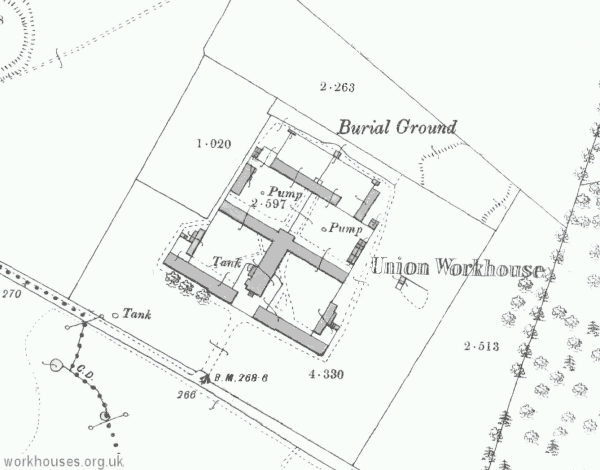Children's Home, Glenamaddy, Co. Galway, Galway, Republic of Ireland
Following the creation of the Irish Free State in 1921, the boards of guardians that had previously administered the country's poor relief system were abolished. The workhouses that had been operated in each of the country's poor law union areas, were either closed or turned over to use as hospitals or various forms of social welfare homes.
Between 1921 and 1925, the former Glenamaddy union workhouse, located on the R362 to the south-east of Glenamaddy, operated as the county's 'Children's Home' — actually a home for unmarried mothers and children, some of the latter being unaccompanied.. It was run by the Bon Secours Sisters, who were paid by the Board of Health at a fixed weekly rate for each inmate.
In June 1924, conditions at the home were described in a newspaper report, an abridged version of which is given below.
The Glenamaddy Children's Home is the third institution in the new County Galway scheme of public health. It was opened in November of 1921, and placed under the control of the Bon Secour nuns, four of whom now manage the institution, assisted by a staff of paid helpers. Them are 130 in the House. These include 87 children from infants in arms to little boys and girls of nine, and 26 mothers.
There are six dormitories in the old workhouse buildings, with highly-placed and gloomy windows. The rooms are small and altogether inadequate to accommodate the little occupants who are to helpless to understand or realise their surroundings. It is in the nature of a grimly ironical comment to read upon a "Child Welfare Chart" hung upon the walls that the sisters should "let in all the light and sunshine and fresh air you can." There is little light or sunshine within the gloomy portal of Glenamaddy workhouse. There are walls which reek with damp in winter, that have not seen the painter's brush for years. There are long, narrow, and gloomy corridors. Water has to be carried for the children's ablutions. There is not a single permanent bath, and the babies have to be bathed in portable fixtures with water carried by the good nurses whose heavy responsibility is increased tenfold by the inadequate accommodation provided.
When the home was first established in Glenamaddy, it was intended that the roofless building across the courtyard should be restored, and that about £10,000 should be expended on repairs and reconstruction. Then the County Board of Health or the Local Government Department or somebody in authority adopted a change of attitude, and the entire question of locale once more came under review. Since then, a procession of inspectors, medical or otherwise, has swarmed to the place, wasting as much money in travelling expenses as could have given the children many a happy day. The home has been condemned again and again, but this condemnation goes no further. The scandal persists.
Why Glenamaddy was ever chosen for its children's home passes comprehension. It is a considerable distance from any railway station, and proportionately expensive to run. For instance, if £2 2s. per ton is paid for coal in Dublin, it costs 25s. 9d.. for carriage and cartage before it is delivered at the home. Need I add that a considerable amount of fuel is necessary in a gaunt and damp building such as that in which nuns and children are now housed? The nuns are compelled to pay 10s. per ton cartage from Glenamaddy to the nearest railway station. Recently they tried to got coal from Galway, and found it cost £6 alone for transport of four tons!
The proposal is now on foot to transfer the home either to Portumna, which, like the central county home in Loughrea, is in the Clonfert diocese, or to Tuam, which, like Glenamaddy, is in the Archdiocese. Tuam is obviously by far the more suitable place. It is near a railway station, forms a convenient county centre within easy reach of the main administrative headquarters at Galway, and it has convent and Christian Brothers schools. Moreover, it contains a building of adequate size for the accommodation of from 200 to 300 inmates and suitable for the segregation of various classes of cases.
Upstairs in the rambling house in Glenamaddy were thirty-three babies, children such as one might see in any nursery in the land. They were brought out in the sunshine to be photographed, and they gurgled gleefully as they sucked "sugar-barley" and played joyfully with the two young mothers who kept watch over them.
The mortality has been low; a few of the older children died from whooping cough, but the death rate amongst the infants has been higher than it ought to have been because of the difficulties of rearing motherless babies.

Former Children's Home inmates, Glenamaddy, 1924.
In 1925, with the building in a very poor condition, increasingly costly to maintain, and lacking a suitable water supply, the establishment moved to new premises at Tuam.
A few sections of ruin are all that now remain of the building.
The home's site is shown on the 1916 map below.

Children's Home site, Glenamaddy, c.1916.

Former Children's Home site, Glenamaddy, 2003. © Peter Higginbotham

Former Children's Home site, Glenamaddy, 2003. © Peter Higginbotham
Records
Note: many repositories impose a closure period of up to 100 years for records identifying individuals. Before travelling a long distance, always check that the records you want to consult will be available.
- Galway local archives, Island House, Cathedral Square, Galway.
Bibliography
- Nicolson, Jill Mother and Baby Homes: a survey of homes for unmarried mothers (1968, Allen & Unwin)
- Redmond, Paul Jude he Adoption Machine: The Dark History of Ireland's Mother and Baby Homes and the Inside Story of How Tuam 800 Became a Global Scandal
Links
- None identified at present.
Except where indicated, this page () © Peter Higginbotham. Contents may not be reproduced without permission.


